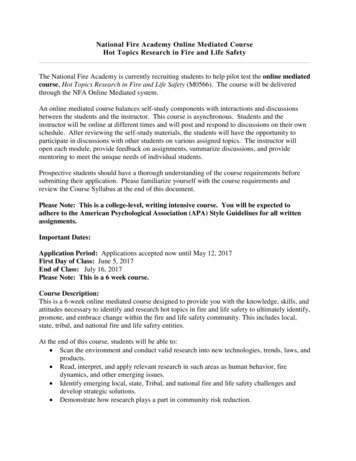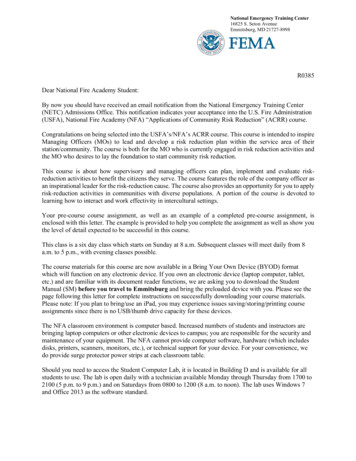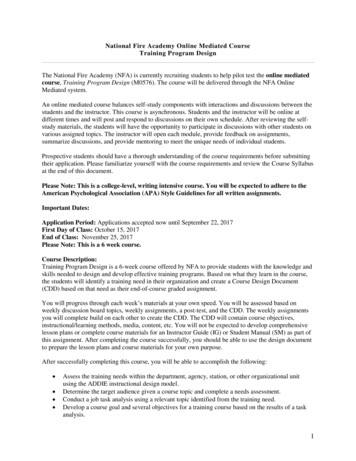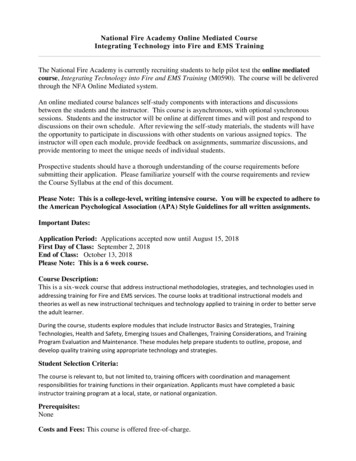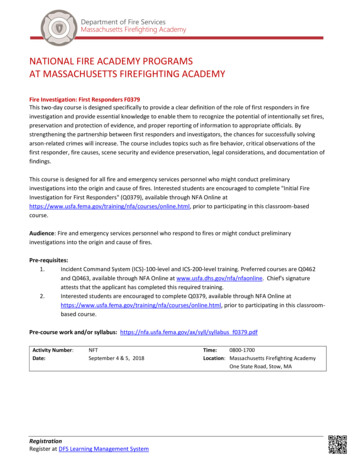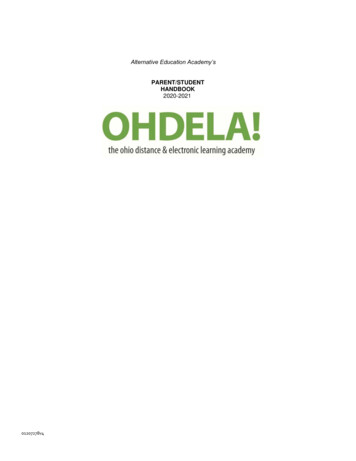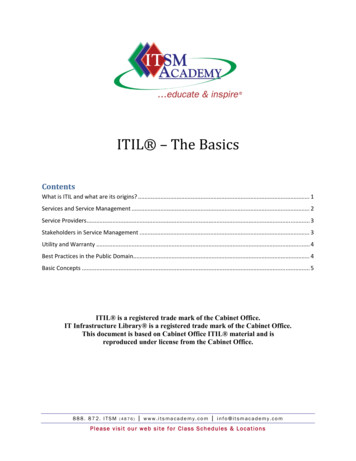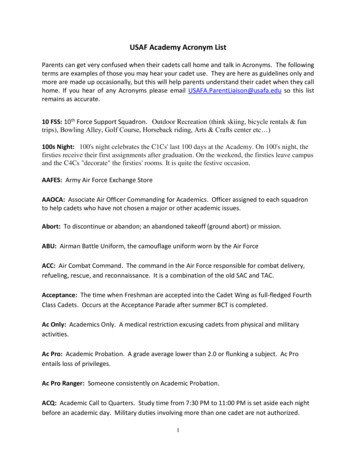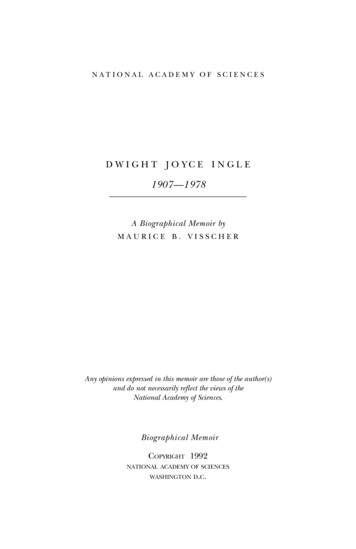
Transcription
national academy of sciencesDw i g h t j o y c e I n g l e1907—1978A Biographical Memoir bymaurice b. visscherAny opinions expressed in this memoir are those of the author(s)and do not necessarily reflect the views of theNational Academy of Sciences.Biographical MemoirCopyright 1992national academy of scienceswashington d.c.
DWIGHT JOYCE INGLESeptember 4, 1907-July 28, 1978BY MAURICE B. VISSCHERIT is DIFFICULT to compress into a memoir of reasonablelength the story of a scientist who was born on anIdaho ranch, educated in an ungraded elementary schooland small town high school, attended a newly establishedstate university, and yet went on to become a first-rank,pioneering scientist in a new and uncharted field. Yeteven from this short account it will be apparent that hislife was of importance to the advancement, philosophy,and ethics of science.The period of Dwight Ingle's active life was the time ofrapid development in endocrine science, to which Inglehimself contributed greatly. His career included a seriesof statistically improbable successful ventures, chronicledin his autobiography, / Went to See the Elephant.1 The titlecomes from John Godfrey Saxe's story of "the six blindmen of Indostan," who describe an elephant according tothe part of the animal they can touch with their hands,and Ingle displayed genuine modesty in choosing it, for, ashe explains in the book's preface, "Science does involvelooking at some specific properties of systems that are toobig to get into perspective." With a simple and genuinemodesty, he continues:247
248BIOGRAPHICAL MEMOIRSThis may be the first time that a non-famous scientist has written anautobiography. I hope it will show that an ordinary fellow can have funbeing a scientist. There has been some self-direction in my life, but it maywell be that the origin of some of my drives and faiths are hidden. Fortuityhas played an important role in determining my interest, opportunities,and what has become of me. 1EDUCATION AND EARLY LIFEDwight Joyce Ingle was born September 4, 1907, on a ranchnear Kendrick, Idaho. He attended a small country elementary school and graduated from high school in Kendrick. Ateighteen he entered the University of Idaho with a career as aphysical education director in mind. Interested in weightlifting and wrestling since he was a boy, he had not yet acquired any real interest in science though he was a voraciousreader. This situation changed very soon under the influenceof the faculty.Ingle's first serious scientific interest was in the field ofpsychology, which perhaps intrigued him because he engaged in summer work in state mental hospitals in Idaho.As he tells the story in his autobiography, he soon becamedisillusioned with the treatment and methods of care thenavailable for the mentally ill, coming early to the conclusion that psychoses are organic illnesses. His interests, therefore, shifted to physiological psychology. Earning the Bachelorof Science degree at the University of Idaho in 1929, he enrolled there as a graduate student and earned a Master's degree in psychology in 1931. During his years at the Universityof Idaho, Ingle began reading the literature of endocrinologyand studying adrenalectomized animals. He supported himself as a graduate student by working part time as a laboratoryanimal caretaker and by grading examination papers.The Great Depression was then under way in the UnitedStates, and life was hard for most graduate students. Inglewas offered a small stipend as a teaching assistant at the Uni-
DWIGHT JOYCE INGLE249versity of Minnesota that allowed him to continue his graduate studies. He knew of Karl Lashley and others' basic work inphysiological psychology at Minnesota and planned to emulate them. As it happened, however, his interests and hiswork shifted from psychology to fundamental endocrinology.The author of this memoir was a member of the University of Minnesota Graduate School Committee that conducted Dwight Ingle's final examinations for the Ph.D. degree. He had majored in psychology and minored in physiology,of which I was the representative. My first experience withthe candidate was in connection with his petition to theGraduate School to be exempted from the foreign languagerequirements for the Ph.D., which had never been waivedbefore that time, and I remember vividly the consternationthis request raised in the Graduate School community.Ingle's examining committee took account of the sixty highquality scientific papers that he had already published andconcluded that Ingle had demonstrated his fitness for a doctorate. There was no dissent among the committee members.The Ingle case was a landmark decision for the Graduate School at Minnesota and was followed by many moreexamples of breaking traditional rules and regulations atthat institution. I was somewhat surprised, therefore, that Inglehimself made no mention in his autobiography of his stubborn refusal to bother with things like foreign language requirements, which he undoubtedly considered much lessimportant than learning how to remove part or all of a rat'spituitary gland at the age of weaning. He was, of course, right,but in his mention of his Ph.D. examination he refers onlyto the fact that he was asked only one question relating topsychology, his major field, the examination being dominatedby questions on biology and physiology.After completing his graduate studies at the Universityof Minnesota Ingle moved to the Mayo Clinic, where he
250BIOGRAPHICAL MEMOIRSwas a Mayo Fellow for four years and collaborated withE. C. Kendall's group in studies of the hormones of theadrenal cortex. He then became a Cox Medical ResearchFellow at the University of Pennsylvania, where he workedfor three years under the sponsorship of Dr. F. D. W. Lukens.After the termination of the Cox Fellowship, Ingle workedfor the Upjohn Company in Kalamazoo, Michigan. In histwelve years there he became a senior research scientistand conducted a basic research program in endocrinologywithout pressure to work on problems of specific importance to the company. Yet he became restive, and when hewas offered a professorship of physiology in The Universityof Chicago's Ben May Institute, he left Michigan for Chicago, remaining there from 1953 until his retirement twentyyears later. Chairman of the Department of Physiology fornine years, he was not happy as an academic administratorand relinquished the post before he retired.INGLE AND THE NEW FIELD OF ENDOCRINOLOGYAs noted above, Ingle came onto the scientific scenewhen endocrinology was emerging as a major field of science. He offered the new field freshness of approach andimagination, strict critical thinking, and boundless energyfor painstaking work. Perhaps his greatest asset was hisability to define problems in a way that could be answeredby direct observation in experimental situations. In reviewing his very large scientific output, it is obvious that heexcelled at asking specific questions and spared no painsin devising methods to answer them.Ingle is responsible for at least three signal advances inendocrine science—development of a bioassay for adrenalcortical hormones that facilitated the purification of cortisone, documentation that the adrenal cortex and the pituitary gland interact by a negative feedback mechanism, and
DWIGHT JOYCE INGLE251characterization of the permissive role of adrenal hormonesin homeostatic control mechanisms. His contributions aredescribed in detail in his own autobiography1 and inE. C. Kendall's autobiography.2The first of these advances stemmed from a 1934 paperin which Ingle (together with W. T. Heron and W. M.Hales) reported that repetitive contraction of skeletal musclerequires an intact adrenal cortex. Ingle suggested to E. C.Kendall that this phenomenon could be utilized as a bioassay for the activity of adrenal cortical extracts. Kendall immediately realized the potential of such a bioassay in thepurification of adrenal hormones and invited Ingle to joinhis group at the Mayo Clinic, an appointment that Kendalldescribed as a turning point in the purification of the glucocorticoid hormone cortisone.2 The assay provided reliabledata as to which purified fractions contained the active principle and gave the Mayo group an advantage over competinglaboratories that lacked such an assay. During these earlystudies he characterized the relation between the adrenal glandand salt and water metabolism, a phenomenon that subsequently became the basis of another bioassay system that ledto the recognition that the adrenal cortex also secretes a mineralocorticoid hormone, later characterized as aldosterone.Another side observation of the studies at the Mayo Clinicled to his second major contribution, namely in 1937 Ingleobserved that the administration of adrenal cortical extracts or purified glucocorticoids to intact rats causes atrophy of the adrenal glands. Adrenal atrophy could be prevented by the simultaneous administration of pituitary extracts,and he subsequently established in collaborative work withHerbert M. Evans and Choh H. Li that the changes inadrenal size and activity are mediated by the pituitary hormone adrenocorticotropin. The elucidation of the feedback relation between the adrenal cortex and the pituitary
252BIOGRAPHICAL MEMOIRSgland served as a paradigm for similar control mechanismsin other endocrine systems.His third major contribution evolved from his studies ofthe physiological actions of adrenal steroid hormones, atrain of thought that led to excursion into diverse aspectsof physiology, including studies of the effects of adrenalsteroids on carbohydrate physiology, investigations on thepathogenesis of hypotension (shock) in animals with adrenal insufficiency, and the effects of severe stress on animals. The damaging effects of stress were widely believedto be due to hypersecretion of the adrenal cortex. However, Ingle showed that the characteristic damaging effectsof stress are produced when adrenal steroids are suppliedto adrenalectomized animals at a constant but not excessiverate of administration. He thus deduced that the role of theadrenal cortex in the stressed state appears to be due to asubtle "permissive" or supporting role rather than as the primary mediator of the stress reaction. This paradigm has hadan enormous impact on the analysis of endocrine systems.PERSPECTIVES IN BIOLOGY AND MEDICINE ANDTHE ETHICS OF RESEARCHAt Chicago Ingle founded a hybrid journal of a type thathad never existed before. Perspectives in Biology and Medicinepublished papers from the interface between the biomedical sciences and the humanities. To Ingle Perspectives wasthe forum where the "ordinary fellow" could explore andintegrate "two cultures"—a term he coined long beforeE. P. Snow applied it as a catch phrase for the gap betweenhumanists and scientists. With the encouragement andhelp of The University of Chicago Press, Ingle provided asingle publication medium to serve the two groups, demonstrating in a practical way that differing points of viewcould have a commonality of objectives.
DWIGHT JOYCE INGLE253Perspectives published various types of speculative essayson basic science and the ethics of biomedical researchparticularly useful at a time when serious problems so often involve situations where biological science and ethicsintersect. Having first provided a forum for the rationalpresentation of varying viewpoints, Ingle used the journalfrequently to air his own analyses of such problems.Ever careful to give credit to his own research staff, Inglefelt particularly strongly about the impropriety of seniorresearch directors who report the results of students without acknowledging their ideas and implementation. At theEndocrine Society's annual banquet in 1959, his presidential address included an elaborate fable about a scientistborn with "a mutation that enhanced the ability of thebrain to function creatively." This mutation had come aboutwhen a clergyman grandfather was struck by a single neutron while "bent over an ice cream freezer at a churchsocial." Skipping the son, who became a mail carrier, itmanifested itself in the grandson.Tongue in cheek, Ingle went on to describe how thegrandson became a promising graduate student and madean entirely independent discovery that greatly pleased hisadvisor. The advisor asked the young man if he might disclose the finding publicly in an important address he wasabout to deliver. Receiving consent, he dutifully reportedthat his graduate student had made an exciting discovery.To no one's surprise but the student's, however, the nextday's headlines read, "Professor X announces a major discovery." Professor X then became a noted participant inscientific seminars and a frequent guest lecturer on thesubject of the student's discovery.According to Ingle's fable, Professor X rode to fame andfortune while the young student, if not ignored, was recognized only by serious students of his field. Promoted rap-
254BIOGRAPHICAL MEMOIRSidly in prestigious academic institutions, he soon became afull professor with productive graduate students of his own.One day, a student reported to him a highly significantresult gained from entirely independent studies. As it hap. pened, the young professor was just about to give a talk onthe work going on in his department, and he asked thegraduate student's permission to report his unpublishedresults. He felt a little qualm when he remembered hisown dismay when credit for his work as a student went tohis academic sponsor but reminded himself that he provided the intellectual climate in which his students workedand the stipends to live and develop into creative scientists. And so it was that the grandson announced his student's innovative study, and the next day the headlines read,"Professor Y announces spectacular new scientific results"—with predictably favorable consequences to his career.This tale occupies eight pages of Ingle's autobiography,where he details several stages of the successful scientific career: appointments to journal editorships, membership onfoundation and government grants committees, administrative posts. An inveterate storyteller but never abrasive,he used a gently satirical tone to criticize people of hisown ilk. He poked fun at human frailties but was generousand forgiving.AWARDS AND HONORSIngle received much honor and acclaim for his contributions to endocrinology. He was invited to lecture manytimes at home and abroad. He was awarded the HonoraryDoctor of Science degree by the University of Idaho in1962, received the Koch Award of the Endocrine Society,and was elected to the National Academy of Sciences in1963. He was given the Outstanding Achievement Awardof the University of Minnesota in 1964, the Roche-Organon
DWIGHT JOYCE INGLE255Laurentian Hormone Conference Award, and the UpjohnPrize. He was elected a fellow of the American Academyof Arts and Sciences and was given the Modern MedicineAchievement Award. He was a member of Phi Beta Kappa,Sigma Xi, Alpha Omega Alpha, the American Associationfor the Advancement of Science, the American Physiological Society, the Endocrine Society (president, 1959-60),and the Society for Experimental Biology and Medicine(president, 1965-67)."My research efforts have been driven by curiosity," heonce wrote, when asked what motivated him to do scientific research. "The joy of the daily search has been enhanced by occasional discovery."He will long be remembered as a perceptive, careful,and creative scientist of broad intellectual interests—andas an unusually decent human being; definitely not, as hehimself put it, "an ordinary fellow."NOTES1. D. J. Ingle, / Went to See the Elephant (New York: Vantage Press,1963).2. E. C. Kendall, Cortisone. Memoirs of a Hormone Hunter (New York:Charles C. Scribner's Sons, 1971).
256BIOGRAPHICAL MEMOIRSSELECTED BIBLIOGRAPHYThe entire bibliography is deposited in the Dwight J. Ingle Collection, AmericanHeritage Center Library, The University of Wyoming, Laramie, WY 82071.1934With W. T. Heron and W. M. Hales. Capacity of skeletal muscle inrats to maintain work output. Am. J. Physiol. 110:357-61.1935With W. M. Hales and G. M. Haslerud. Influence of partial adrenalectomy on the work capacity of rats. Am. J. Physiol. 113:200-204.Endocrine function and personality. Psychol. Rev. 42:466-79.1936With E. C. Kendall. Survival of the adrenalectomized nephrectomizedrat. Am.J. Physiol. 116:622-25.With E. C. Kendall. Survival of the adrenalectomized nephrectomizedrat. Am.J. Physiol. 117:200-202.1937With G. M. Higgins. Transplantation and regeneration of the adrenal gland in the rat. Proc. Staff Meet. Mayo Clinic 12:204-5.With E. C. Kendall. The effect in the rat of cortin on the regeneration of the adrenal gland after enucleation. Proc. Staff Meet. MayoClinic 12:505.With R. E. Harris. The influence of destruction of the adrenal medulla on emotional hyperglycemia in rats. Am. J. Physiol. 120:42022.With E. C. Kendall. The significance of the adrenals for adaptationto mineral metabolism. Science 86:18-19.With E. C. Kendall. Atrophy of the adrenal cortex of the rat produced by the administration of large amounts of cortin. Science86:245.1938With G. M. Higgins. Functional homeoplastic grafts of the adrenalgland of newborn rats. Anat. Rec. 70:145-54.With G. M. Higgins. Influence of genetic relationship on the sue-
DWIGHT JOYCE INGLE257cess of homeoplastic transplants of adrenal glands in Albino rats.Proc. Soc. Exp. Biol. Med. 39:165-66.With E. C. Kendall. Weights of adrenal glands in rats fed differentamounts of sodium and potassium. Am. J. Physiol. 122:585—88.With H. D. Moon and H. M. Evans. Work performance of hypophysectomized rats treated with anterior pituitary extracts. Am.J. Physiol. 123:620-24.With G. M. Higgins. Autotransplantation and regeneration of theadrenal gland. Endocrinology 22:458-64.The work performance of untreated hypophysectomized rats. Endocrinology 22:465-68.With G. M. Higgins. The effect of the administration of carbontetrachloride on the extent of regeneration in the enucleatedadrenal gland of the rat. Endocrinology 23:424-28.With G. M. Higgins and E. C. Kendall. Atrophy of the adrenalcortex in the rat produced by the administration of large amountsofcortin. Anat. Rec. 71:363-72.With G. M. Higgins. Regeneration of the adrenal gland followingenucleation. Am. J. Med. Sci. 196:232-39.The effect of administration of large amounts of cortin on the adrenal cortical atrophy in male and female rats. Proc. Staff Meet.Mayo Clinic 13:733-34.A comparison of the amounts of cortin required to produce adrenal cortical atrophy in male and female rats. Proc. Staff Meet.Mayo Clinic 13:733-34.1939With G. M. Higgins. Regeneration of the liver in hypophysectomizedwhite rats. Anat. Rec. 73:95-104.With E. V. Flock and J. L. Bollman. Formation of lactic acid, aninitial process in working muscle. /. Biol. Chem. 129:99-110.With W. C. Corwin. Coagulation time of blood in normal andadrenal-demedullated rats. Proc. Soc. Exp. Biol. Med. 42:82-84.1940With R. E. Harris. The capacity of vigorous muscular activity ofnormal rats and of rats after removal of the adrenal medulla.Am.J. Physiol. 130:151-54.Effect of two steroid compounds on weight of thymus ofadrenalectomized rats. Proc. Soc. Exp. Biol. Med. A
258BIOGRAPHICAL MEMOIRSDiabetogenic effect of some cortin-like compounds. Proc. Soc. Exp.Biol. Med. 44:176-77.Effect of three synthetic steroid compounds upon weight and workperformance of adrenalectomized rats. Proc. Soc. Exp. Biol. Med.44:450-52.With J. Q. Griffith, Jr. Blood volume in experimental hypertensionfollowing subtotal nephrectomy. Effect of posterior pituitarylobectomy. Proc. Soc. Exp. Biol. Med. 44:538-40.With E. C. Kendall. Influence of amorphous fraction from adrenalcortex on efficiency of muscle. Proc. Soc. Exp. Biol. Med. 45:602-6.With A. T. Rasmussen, W. J. Gardner, and T. B. Rasmussen. Effectsof hypophyse
physiological psychology at Minnesota and planned to emu-late them. As it happened, however, his interests and his work shifted from psychology to fundamental endocrinology. The author of this memoir was a member of the Univer-sity of Minnesota Graduate School Committee that con-ducted

